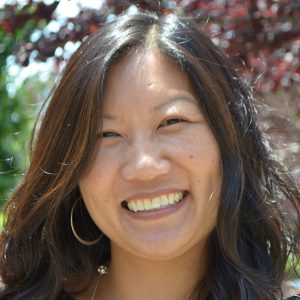Esther Park is the CEO of Cienega Capital, a regenerative investment firm focused on systemic change in soil health, regenerative agriculture, and local food systems. Park has 18-plus years’ experience in mission-based financial services, including microfinance and risk capital investments. As vice president, Strategy and Business Development, RSF Social Finance, she oversaw lending from 2007–2011 and also started to learn about Biodynamic farming. She serves on the boards of Nutiva, City Fresh Foods, Custom Food Solutions, and Carman Ranch Provisions, and is an advisor to Kitchen Table Advisors and Amalgamated Bank.
We caught up with Esther recently to learn more about her approach to investing in regenerative food systems.

Esther Park, CEO of Cienega Capital
How did you get involved in regenerative ag investing?
Sallie Calhoun, who founded Cienega Capital, and with whom I began working in 2014, said, “I really want to work with farmers.” I had never done that before. I dove in. A lot of it is similar to work I had done in the past. It’s very cash-flow–based financing, often minimally produced financial statements or none. The largest-size project in terms of revenues is $20 million. The vast majority are much smaller than that.
What are your criteria, in terms of types of enterprises, key measures and project locations?
Our mission is to regenerate the agricultural soils of North America. A lot are in California because, naturally, that’s where we are, but we have work in Arkansas, Kansas, Oregon, Louisville and Boston. We look closely at “regenerative”—in context. What is going to regenerate soils in Kentucky is going to be different than what it looks like in Oregon than what it looks like in California. …In terms of supply chain, we do have value-add food companies. The connection to the land has to be very strong and they have to be able to trace to the farmer level and know what the practices the farmer is doing on the ground.
Please talk about some current projects.
One of the small-holder family farms in California is Markegard Family Grass-Fed. They mostly graze lands leased to them by conservation groups, but we helped them purchase a piece of property so they could grow their pastured-pig operation.
In Kentucky, we invested in a food-processing company that was committed to buying as much produce from Kentucky small-holder farmers as they possibly could. It was a substantial equity investment that allowed the company to recapitalize at the same time they were cleaning up some legacy things.
How do you measure success?
We reject impact metrics as a way to determine success. We measure with our eyes and our ears. We need to create beauty in these landscapes. We’re in close relationship with all the investments that we make. A lot of the principles of regenerative ag are interconnected: Is there a diversity of plant life where there was less before? Is the ground covered? Is it more covered than before? Are there more species than before? …complexity is one of our values and complexity is not a thing you can measure very well.
Can you talk a bit about rates of return within regenerative-ag investing?
If somebody is just interested in market rates of return, go do something else. …That’s how we got to this problem in the first place—the drive for efficiency and scale. We have already created a financial system and an agricultural system that maximizes…yield, efficiency and scale. We need different expectations and different tools. Why do investors need a certain rate of return and what does it mean to achieve market rates of return? What does that mean in context of accumulation of wealth and the increasing wealth divide, not only in this country, but around the world? In the pursuit of financial return…we have ignored the human and the ecological to the detriment of both. …In some cases, we need to accept a negative financial return in order to bring back in balance the human and ecological.
What are the biggest barriers to investment in regenerative ag?
…the conventional ways in which we think about investment. …we need to stop prioritizing return…We need to invest in people and livelihood on the land. …It doesn’t look like traditional investing. It does take work up front and it does produce lower returns. It can generate healthy returns on a loan portfolio. Market-rate returns, that’s not our goal or what we’re trying to go for.
Esther Park will be participating as a panelist at the Regenerative Food Systems Investment Forum in Oakland, Sept. 30-Oct. 1. Hear more about her approach to investing in regenerative food systems, as well as the strategies employed by other investors at this unique event. Learn more here.
—
Leigh Glenn is a freelance writer and mushroom grower in Central Virginia. She focuses on farming, food, ecology and the arts.
